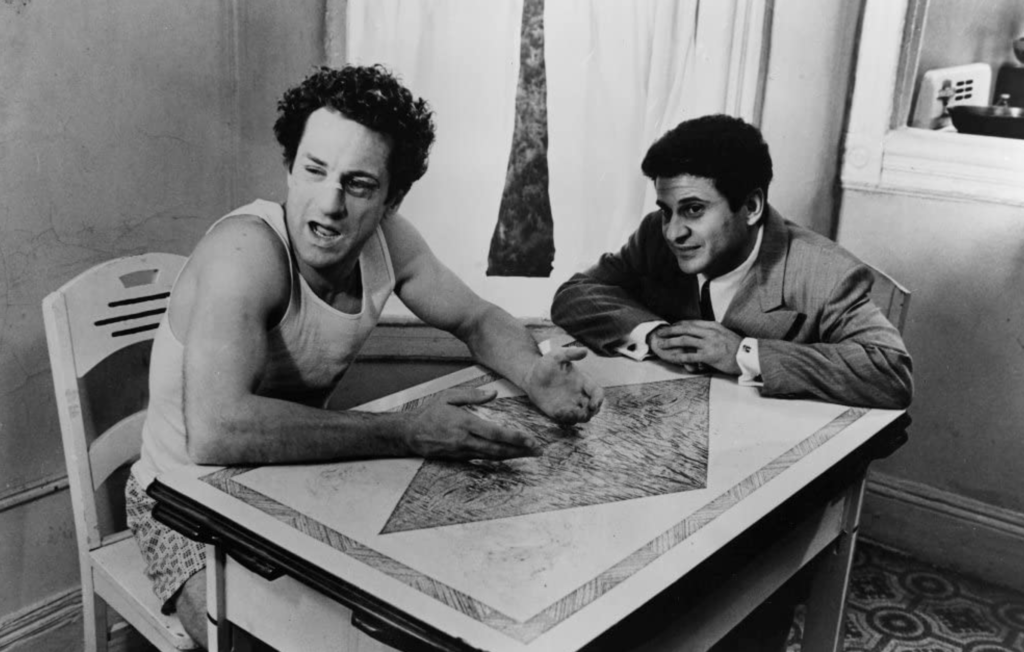“Hey, Ray, I never went down..”
In the realm of cinema, there are a few films that can be deemed true masterpieces, standing the test of time and leaving an indelible mark on the medium. Martin Scorsese’s “Raging Bull,” released in 1980, is unquestionably one of those films. It transcends the boundaries of traditional storytelling, employing a mesmerizing blend of visual artistry, powerful performances, and meticulous direction. Exploring the tumultuous life of boxer Jake LaMotta, “Raging Bull” showcases the epitome of filmmaking as an art form, captivating audiences with its raw emotion and technical brilliance.

A Visual Tapestry: One of the most remarkable aspects of “Raging Bull” lies in its visual composition. Scorsese, together with his longtime collaborator, cinematographer Michael Chapman, weaves a visual tapestry that immerses the viewer in the gritty world of boxing and the turbulent life of Jake LaMotta. The film’s black-and-white cinematography, a bold artistic choice, lends it a timeless quality, enhancing the rawness and intensity of the narrative. The stark contrast and shadows create a palpable sense of claustrophobia and inner turmoil, mirroring the emotional landscape of the characters.
Scorsese’s use of slow-motion sequences throughout the film is nothing short of masterful. In the boxing ring, the slowed-down movements not only capture the physicality of the sport but also allow the audience to glimpse the inner psyche of LaMotta. These sequences become moments of introspection, revealing the vulnerability and self-destructive nature of the protagonist.
Powerful Performances: No discussion of “Raging Bull” can be complete without acknowledging the extraordinary performances that elevate the film to new heights. Robert De Niro’s portrayal of Jake LaMotta is nothing short of a tour de force. De Niro fully immerses himself in the role, physically transforming his body to match the boxer’s physique and capturing the complexities of LaMotta’s character. From the explosive rage to the moments of introspection and self-loathing, De Niro’s performance is an acting masterclass, showcasing his dedication and artistic commitment.
Equally compelling is Joe Pesci’s performance as Joey LaMotta, Jake’s younger brother and manager. Pesci brings a raw intensity and authenticity to the role, effectively portraying the love-hate relationship between the brothers. Their on-screen chemistry is electric, generating palpable tension and amplifying the emotional impact of the film.

Meticulous Direction: At the helm of “Raging Bull,” Martin Scorsese demonstrates his exceptional directorial prowess. With meticulous attention to detail, Scorsese crafts each frame with precision and purpose, enhancing the film’s thematic depth. The use of symbolism and recurring motifs, such as the recurring shots of blood, the ring ropes, and the prison bars, adds layers of meaning to the narrative, inviting viewers to delve deeper into the psychology of the characters.
Scorsese’s unconventional narrative structure, employing flashbacks and fragmented storytelling, mirrors the fragmented psyche of Jake LaMotta. The film presents a nonlinear exploration of memory and redemption, inviting the audience to piece together the puzzle of LaMotta’s life, simultaneously revealing the destructive patterns that define him.
Conclusion: “Raging Bull” is a true testament to the artistry of filmmaking. From its visually striking composition to the powerhouse performances and masterful direction, the film transcends its boxing backdrop to become a profound exploration of human nature, obsession, and self-destruction. Decades after its release, “Raging Bull” continues to inspire and influence filmmakers, reminding us of the boundless potential of cinema as an art form. It stands as a cinematic masterpiece, reminding us that true artistry can move us, challenge us, and leave an indelible impact on our lives.